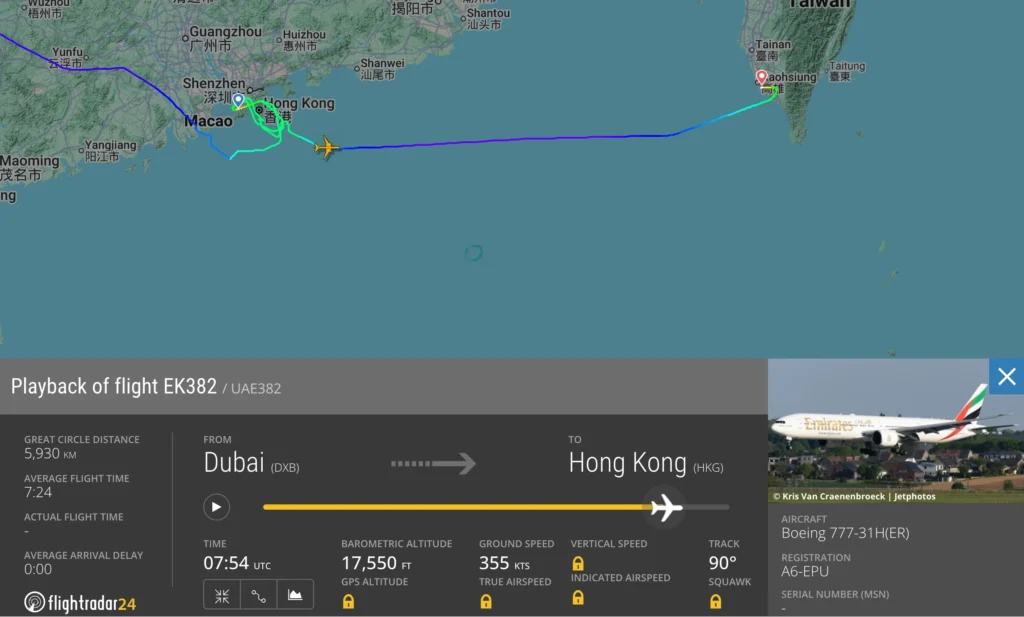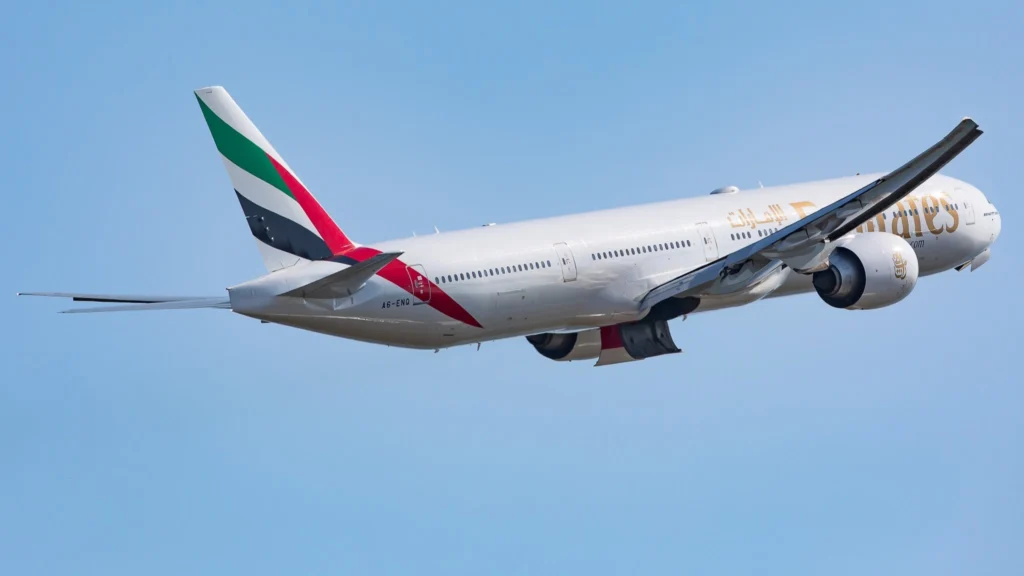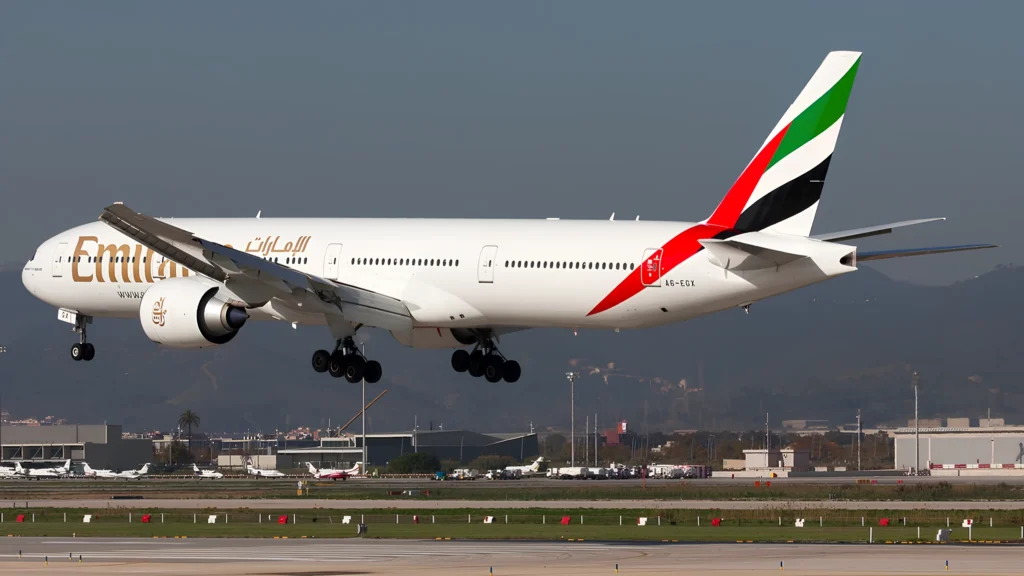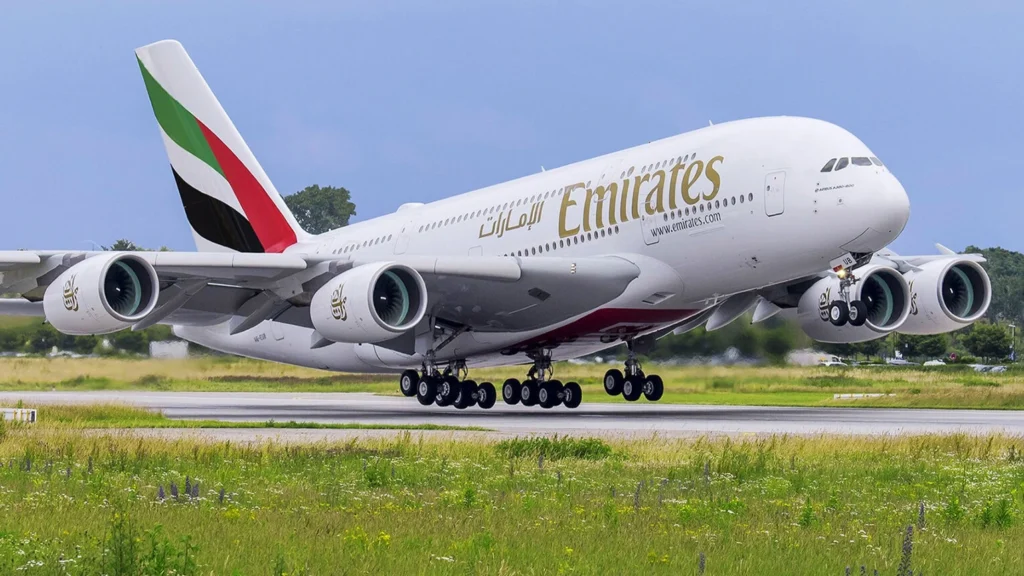
HONG KONG— UAE flag carrier Emirates Airline (EK), operating flight EK382 from Dubai International Airport (DXB) to Hong Kong International Airport (HKG), was unexpectedly diverted on 14 July 2025 to Kaohsiung International Airport (KHH) in Taiwan.
The Boeing 777-31H(ER), registered A6-EPU, was forced to abandon its approach to Hong Kong (HKG) after multiple landing attempts, eventually diverting to Taiwan for operational and safety reasons.
 Photo: FlightRadar24
Photo: FlightRadar24Emirates 777 Failed to Land at Hong Kong
Emirates flight EK382, a long-haul service from Dubai (DXB) to Hong Kong (HKG), encountered significant challenges during its arrival phase.
As per the flight data, the aircraft made at least two unsuccessful landing attempts at HKG.
Flight tracking visuals show the aircraft holding patterns over the Pearl River Delta region before the decision to divert was made.
While unconfirmed reports cited a medical emergency onboard as the cause of diversion, conflicting reports have emerged. An aviation observer noted that weather conditions, particularly sustained winds of approximately 12 knots, may have contributed to the difficulties in landing.
Some speculate that Emirates opted for diversion to avoid further risks or potential scrutiny over operational decisions, just like in the 2023 Singapore runway excursion incident.
The aircraft eventually landed safely at Kaohsiung International Airport (KHH) in Taiwan, marking a significant deviation from the planned destination. No official details on the medical emergency or specific weather challenges have been publicly disclosed by Emirates (EK).
The next day, on July 15, 2025, aircraft A6-EPU operated a reposition flight from Kaohsiung to Hong Kong as UAE382D.
 Photo: Clément Alloing
Photo: Clément AlloingAircraft and Flight Details
- Flight Number: EK382 / UAE382
- Aircraft: Boeing 777-31H(ER)
- Registration: A6-EPU
- Departure: Dubai International Airport (DXB) — 03:15 local time
- Planned Arrival: Hong Kong International Airport (HKG)
- Actual Diversion: Kaohsiung International Airport (KHH), Taiwan
- Flight Date: 14 July 2025
The Boeing 777-31H(ER) is a widebody, long-range aircraft capable of enduring extended diversions such as the one executed during this flight.
 Photo: Clément Alloing
Photo: Clément AlloingWeather and Airport Conditions
Although winds of 12 knots are generally manageable for large aircraft like the 777-300ER, local weather conditions, including crosswinds, low visibility, or turbulence around Hong Kong (HKG), may have contributed to the missed approaches.
Hong Kong’s airport is known for challenging weather patterns due to its coastal location and surrounding terrain.
However, without an official statement detailing the operational reasons beyond the medical emergency, the precise cause remains speculative.
The decision to divert prioritised passenger safety and ensured the onboard medical concern received timely attention.
 Photo: Emirates
Photo: EmiratesSimilar Incident
Emirates flight EK225 (UAE51N), operated by an Airbus A380-841, executed a smooth go-around at San Francisco International Airport (SFO) after encountering windshear at just 50 feet above the ground.
The aircraft, registered as A6-EUV, safely completed its landing on the subsequent approach without incident.
The flight departed from Dubai International Airport (DXB) at 8:57 AM local time and reached SFO after nearly 16 hours of flight. Despite the challenging conditions, the skilled crew navigated the situation effectively, showcasing operational proficiency.
Emirates flight EK225, using the Airbus A380-841 powered by four Rolls-Royce engines, was on approach to San Francisco International Airport (SFO) on March 19, 2025. The aircraft was preparing for final landing when it encountered windshear — a sudden change in wind speed and direction — at approximately 50 feet altitude, a critical phase of landing.
Flight data from FlightAware confirms the aircraft’s departure from Dubai International Airport (DXB), Gate A23. The A380 initiated the go-around maneuver smoothly upon detecting the windshear, an action essential for safety under such volatile conditions.
The pilots managed a seamless transition to a higher altitude, re-entered the landing sequence, and successfully landed at SFO, proceeding to Gate A6 without further complications.
Details of the Go-Around at San Francisco
Go-arounds are a standard aviation safety procedure employed when approach or landing conditions compromise safety.
The Federal Aviation Administration (FAA) Air Traffic Organization data indicates that go-arounds occur in roughly 0.3% of arrivals at major hub airports across the U.S.
In San Francisco, this rate aligns with national averages, with historical data showing 0.3% in fiscal year 2016 and 0.4% in fiscal year 2017, equating to two to three go-arounds per day.
Unlike some past incidents, such as the March 2, 2023, runway excursion of another Emirates A380 in Singapore (SIN), where a failure to execute a go-around led to a serious event amid heavy rainfall, the SFO maneuver exemplifies textbook handling of adverse conditions.
The Singapore incident, investigated by the Transport Safety Investigation Bureau (TSIB), concluded that non-compliance with the Pilot Monitoring’s (PM) instructions contributed to the event, underscoring the necessity of effective cockpit communication.
Stay tuned with us. Further, follow us on social media for the latest updates.
Join us on Telegram Group for the Latest Aviation Updates. Subsequently, follow us on Google News
Emirates A380 Pilots land at New York JFK with One failed engine
The post Emirates 777 Pilots Failed to Land Twice at Hong Kong, Flight Diverted appeared first on Aviation A2Z.


















